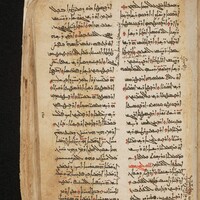-
Title
-
Lexicon of Isho Bar Ali
-
Creator
-
Isho Bar Ali
-
Date
-
9th century
-
Description
-
In his lexicon, Isho Bar Ali, a 9th century member of the Church of the East, gave definitions of the terms Syriac and Aramean; here is a corrected translation, with clean punctuation:
“Aram is Haran in Mesopotamia.
Arameans are the Syrians, as Naaman was an Aramean.
‘Oromoyo’ (Aramean), when the resh (ܪ) is open (Ormoyo), means a worshipper of idols, a pagan; ‘Nabataean’ in another sense.
In another sense, from Aram, which is Syria, ‘Oromoyo’ is ‘Suryoyo’ (Syriac); and again from Aram, which is Haran, the ancient city of idolaters.”
“Ormoyo” (ܐܳܪܡܳܝܳܐ) in Syriac can denote a pagan by pronunciation and context, specifically when a vowel is missing or the resh is read “open,” yielding a form like ܐܳܪܡܳܝܳܐ instead of ܐܳܪܳܡܳܝܳܐ. Bar ʿAli carefully distinguishes Aramean from pagan on the basis of that vowel; the former is an ethnonym, the latter a religious label that can arise from pronunciation. He even adds that in another sense the word can mean Nabataean.
Isho Bar Ali also equates Aram with Upper Mesopotamia concentrated around Harran, which he identifies with Paddan-Aram (“the field of Aram”) in the Bible. Harran lies just below Urhoy (Edessa), about 206 kilometers west of Mardin and the Tur Abdin region. This reflects a geographical understanding of Aram as the northern Mesopotamian plain that served as the heartland of the ancient Arameans.
He then closes by defining Aram as Syria in the Greek rendering, which explains how Aramean (Ormoyo) yields Syriac (Suryoyo). Finally, he returns to his first regional definition, identifying Aram with the Harran-centered zone of Upper Mesopotamia.
In summary, Isho Bar Ali teaches that Aramean means Syriac, irrespective of location, because Aram came to be rendered as Syria/Syriac in Greek. At the same time, he defines Aram geographically as the region of Upper Mesopotamia concentrated around Harran, the ancient “field of Aram.”
-
Language
-
Syriac
-
Publisher
-
HMML Proj. Num: CFMM 00469, f. 56r.
-
w3id.org
 12.jpg
12.jpg 
